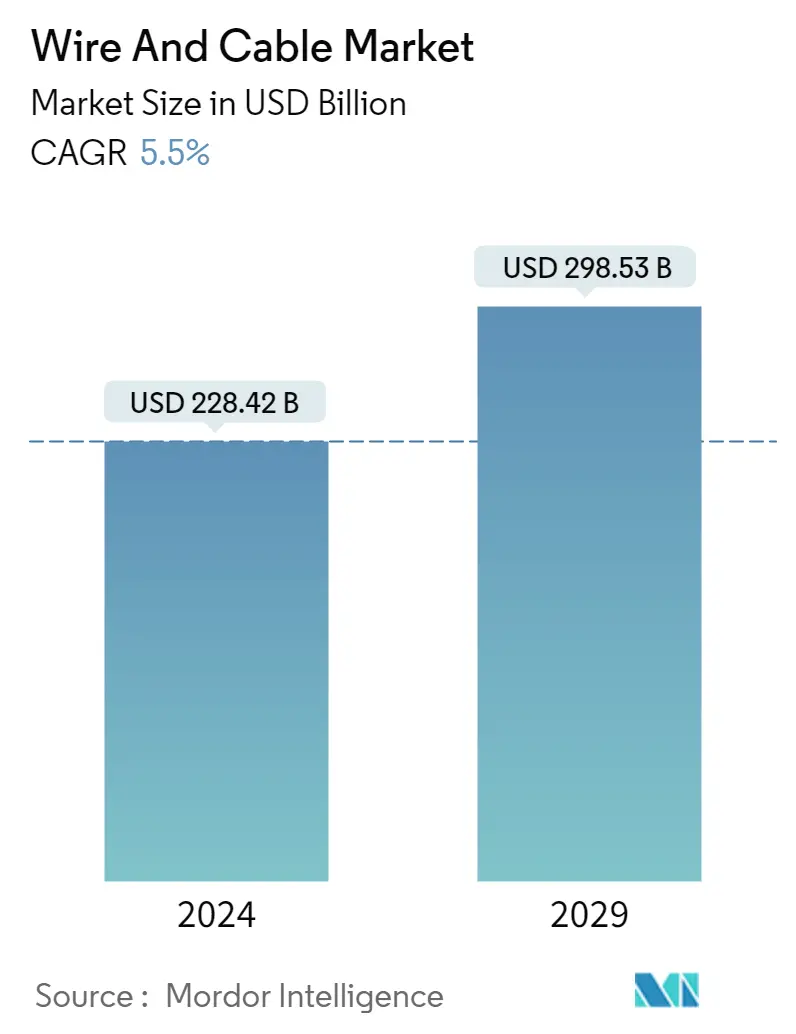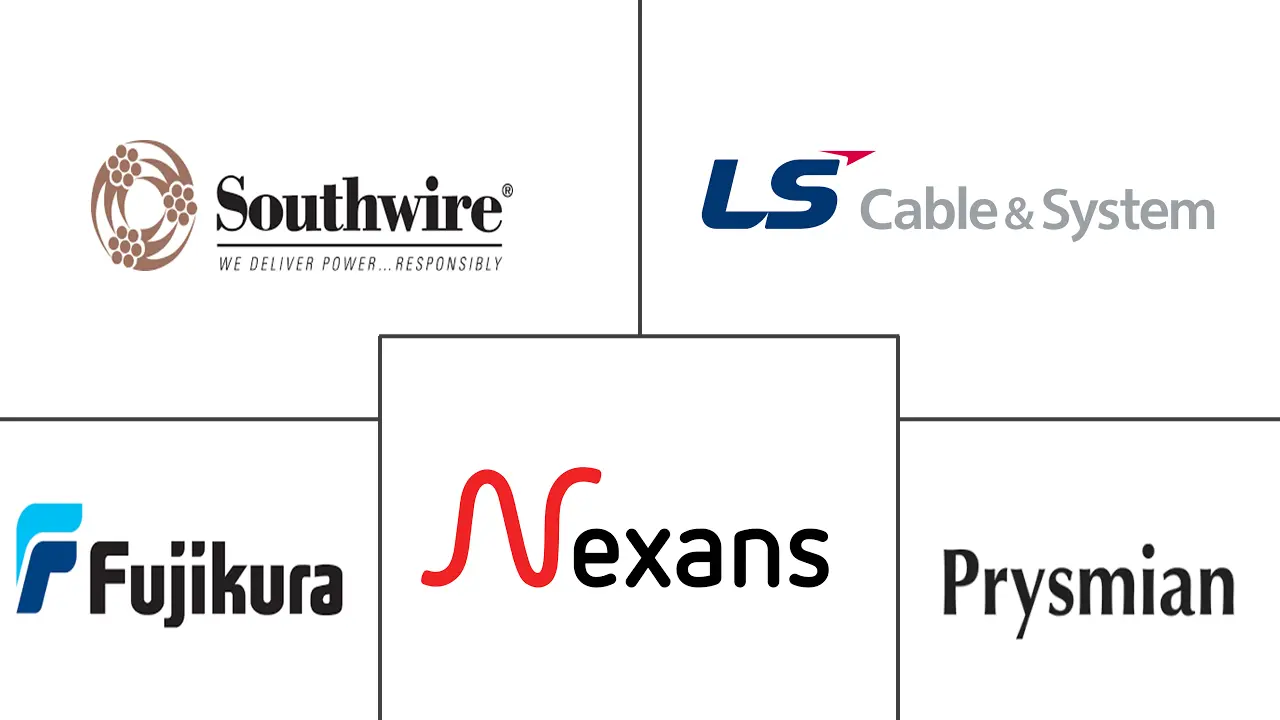Market Size of Wire And Cable Industry

| Study Period | 2019 - 2029 |
| Market Size (2024) | USD 228.42 Billion |
| Market Size (2029) | USD 298.53 Billion |
| CAGR (2024 - 2029) | 5.50 % |
| Fastest Growing Market | Asia Pacific |
| Largest Market | Asia Pacific |
Major Players
*Disclaimer: Major Players sorted in no particular order |
Wires and Cables Market Analysis
The Wire And Cable Market size is estimated at USD 228.42 billion in 2024, and is expected to reach USD 298.53 billion by 2029, growing at a CAGR of 5.5% during the forecast period (2024-2029).
The growing renewable energy production, increasing reserves in smart grid technology, and government initiatives globally for upgrading distribution and transmission systems are responsible for market proliferation. In the past few years, content and cloud providers have attempted to attract more customers and offer bandwidth-intensive services, increasing submarine infrastructure popularity. The lifespan of a submarine cable is expected to be 25 years.
- Cable manufacturing companies are also significantly increasing fire-resistant cable production capacities to keep pace with the increasing need for construction products. Fire-resistant cables are designed to limit the propagation of flames. They have a sheet to determine the smoke and other toxic gases released. Such wires are designed for commercial buildings and wiring in large residential and manufacturing units. The major players offering fire-resistant cables include Nexans, TPC Wire & Cable Corp., Prysmian Group, Cavicel, Cleveland Cable, and others.
- In July 2022, US communications infrastructure provider launched the Zeus subsea route connecting the United Kingdom and continental Europe as cloud service providers desire faster internet connection. Undersea cables transmit almost all internet data traffic. Numerous technology companies, including Alphabet's Google and Meta, have also invested in building subsea cables. Using telecom connectors, extensive data can be transmitted over long distances via electronic or electrical means. They could be seen at the end of telecom cables that transmit data and offer telephony services. Growing demand for connectivity and internet access positively drives the market's growth. The growing need for higher internet speed and better connectivity eventually requires robust and efficient cable connectivity, which fiber optic technology fulfills. The connectors help protect optic fiber, positively boosting the market's growth.
- 5G network applications are rapidly gaining momentum, and IT connector systems play a crucial role. Due to ever-higher signal frequencies, data rates, packing density, and signal integrity requirements, the need for high-performance and high-quality board-to-board connection solutions is also growing.
- The growing demand for connectivity in developing nations for cable producers presents significant business prospects. Yet factors such as installing fiber optic cables provide several operational difficulties for market growth.
- The COVID-19 pandemic had a remarkable impact on the market studied, with several end-user industries that deploy wire and cables facing several difficulties. The spread of COVID-19 across the United States and Europe has forced telecom regulators to postpone 5G spectrum auctions. For instance, in Portugal, Vodafone, NOS, and MEO had to wait for frequency rights in various frequency bands such as 700 MHz, 1800 MHz, 900 MHz, 2.6 GHz, 2.1 GHz, and 3.6 GHz bands.
Wires and Cables Industry Segmentation
A cable consists of more insulated wires wrapped in a single jacket that permits them to pass through, whereas a wire is a single conductor. The scope of the study includes various forms of wire and cable installations deployed in essential end-user facilities such as telecommunications, construction, and power infrastructure.
The market is segmented by cable type, which includes low voltage energy, power cable, fiber optic cable, signal & control cable. By end-user vertical, the market is segment into construction, telecommunications, power infrastructure. The construction segment includes residential & commerical, telecommunication segment covers IT & telecom, while the power infrastructure covers enery & power and Automotive. Further based on Geography the maket is segmented into North America, Europe, Asia Pacific, Latin America, and Middle East & Africa. The market sizes and forecasts are provided in terms of value (USD) for all the segments.
| By Cable Type | |
| Low Voltage Energy | |
| Power Cable | |
| Fiber Optic Cable | |
| Signal and Control Cable | |
| Other Cable Types |
| By End-user Vertical | |
| Construction (Residential & Commercial) | |
| Telecommunications (IT & Telecom) | |
| Power Infrastructure (Energy & Power, Automotive) | |
| Others End-user Verticals |
| By Geography | ||||||
| ||||||
| ||||||
| ||||||
| Latin America | ||||||
| Middle East and Africa |
Wire And Cable Market Size Summary
The wires and cables market is poised for significant growth, driven by advancements in renewable energy production, smart grid technology, and global government initiatives aimed at upgrading distribution and transmission systems. The increasing demand for connectivity, particularly in developing nations, presents substantial business opportunities for cable producers. The market is also witnessing a surge in the production of fire-resistant cables, catering to the rising need for safety in commercial and residential constructions. The proliferation of submarine infrastructure, fueled by the demand for bandwidth-intensive services, underscores the importance of undersea cables in global data transmission. Major technology companies are investing heavily in submarine cable networks to enhance internet connectivity and speed, further propelling market expansion.
The market landscape is highly competitive, with key players like Nexans, Prysmian Group, and Southwire Company LLC actively engaging in partnerships and product innovations to capture market share. The Asia-Pacific region holds a dominant position, with countries like China and India driving demand through renewable energy projects and infrastructure development. The government's support for 5G deployment worldwide is a significant catalyst for market growth, as fiber optic technology becomes increasingly essential for high-speed connectivity. Despite challenges such as the operational difficulties in installing fiber optic cables, the market is expected to thrive, supported by technological advancements and strategic investments by leading companies.
Wire And Cable Market Size - Table of Contents
-
1. MARKET INSIGHTS
-
1.1 Market Overview
-
1.2 Industry Attractiveness - Porter's Five Forces Analysis
-
1.2.1 Bargaining Power of Suppliers
-
1.2.2 Bargaining Power of Buyers
-
1.2.3 Threat of New Entrants
-
1.2.4 Threat of Substitutes
-
1.2.5 Intensity of Competitive Rivalry
-
-
1.3 An Assessment of the Impact of Key Macroeconomic Trends
-
-
2. MARKET SEGMENTATION
-
2.1 By Cable Type
-
2.1.1 Low Voltage Energy
-
2.1.2 Power Cable
-
2.1.3 Fiber Optic Cable
-
2.1.4 Signal and Control Cable
-
2.1.5 Other Cable Types
-
-
2.2 By End-user Vertical
-
2.2.1 Construction (Residential & Commercial)
-
2.2.2 Telecommunications (IT & Telecom)
-
2.2.3 Power Infrastructure (Energy & Power, Automotive)
-
2.2.4 Others End-user Verticals
-
-
2.3 By Geography
-
2.3.1 North America
-
2.3.1.1 United States
-
2.3.1.2 Canada
-
-
2.3.2 Europe
-
2.3.2.1 United Kingdom
-
2.3.2.2 Germany
-
2.3.2.3 France
-
2.3.2.4 Rest of Europe
-
-
2.3.3 Asia-Pacific
-
2.3.3.1 China
-
2.3.3.2 Japan
-
2.3.3.3 India
-
2.3.3.4 Rest of Asia-Pacific
-
-
2.3.4 Latin America
-
2.3.5 Middle East and Africa
-
-
Wire And Cable Market Size FAQs
How big is the Wire And Cable Market?
The Wire And Cable Market size is expected to reach USD 228.42 billion in 2024 and grow at a CAGR of 5.5% to reach USD 298.53 billion by 2029.
What is the current Wire And Cable Market size?
In 2024, the Wire And Cable Market size is expected to reach USD 228.42 billion.

